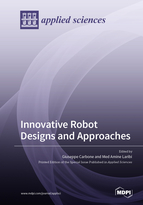Innovative Robot Designs and Approaches
A special issue of Applied Sciences (ISSN 2076-3417). This special issue belongs to the section "Robotics and Automation".
Deadline for manuscript submissions: closed (10 November 2021) | Viewed by 42508
Special Issue Editors
Interests: robotics; robot design; mechatronics; walking hexapod; design procedure; mechanics of machinery; leg–wheel
Special Issues, Collections and Topics in MDPI journals
Interests: robotics; biomechanical engineering; rehabilitation; biomimicry; mechanical design; service robotics; human–robot collaboration; compliant joint
Special Issues, Collections and Topics in MDPI journals
Special Issue Information
Dear Colleagues,
At present, the implementation and role of robots are rapidly changing while attracting increasing interest in innovative solutions within a fast-growing potential market in novel fields such as service robotics, surgical and rehabilitation robotics, and assistive robotics. In this frame, significant attention still needs to be addressed at new concepts, solutions, and applications.
A valuable example is given by cable-driven parallel robots (CDPRs), as their conceptual design can provide a key performance in terms of large workspace, reconfigurability, large payload capacity, and dynamics. The interest of researchers is focused on their novelty and open issues originating from the nature of cables. Unlike classical parallel robots, CDPRs consist in unidirectional force transmission limbs with clear potential advantages in a wide range of application tasks. Due to the distinct merits of the CDPRs, they are already implemented in a variety of fields, ranging from industrial to entertainment applications, and innovative solutions and applications are still being investigated.
This Special Issue aims at attracting cutting-edge research and review articles on any innovative robot. Papers are particularly welcome on topics that are related to theory, design, practice, and applications of robots, including but not limited to the following:
- Innovative design methods and solutions;
- Innovative robotic architectures;
- Novel applications;
- Novel modeling and simulation approaches (including kinematics, dynamics, motion planning);
- Innovative control approaches;
- Safety-related issues.
Prof. Dr. Giuseppe Carbone
Prof. Dr. Med Amine Laribi
Guest Editors
Manuscript Submission Information
Manuscripts should be submitted online at www.mdpi.com by registering and logging in to this website. Once you are registered, click here to go to the submission form. Manuscripts can be submitted until the deadline. All submissions that pass pre-check are peer-reviewed. Accepted papers will be published continuously in the journal (as soon as accepted) and will be listed together on the special issue website. Research articles, review articles as well as short communications are invited. For planned papers, a title and short abstract (about 100 words) can be sent to the Editorial Office for announcement on this website.
Submitted manuscripts should not have been published previously, nor be under consideration for publication elsewhere (except conference proceedings papers). All manuscripts are thoroughly refereed through a single-blind peer-review process. A guide for authors and other relevant information for submission of manuscripts is available on the Instructions for Authors page. Applied Sciences is an international peer-reviewed open access semimonthly journal published by MDPI.
Please visit the Instructions for Authors page before submitting a manuscript. The Article Processing Charge (APC) for publication in this open access journal is 2400 CHF (Swiss Francs). Submitted papers should be well formatted and use good English. Authors may use MDPI's English editing service prior to publication or during author revisions.







